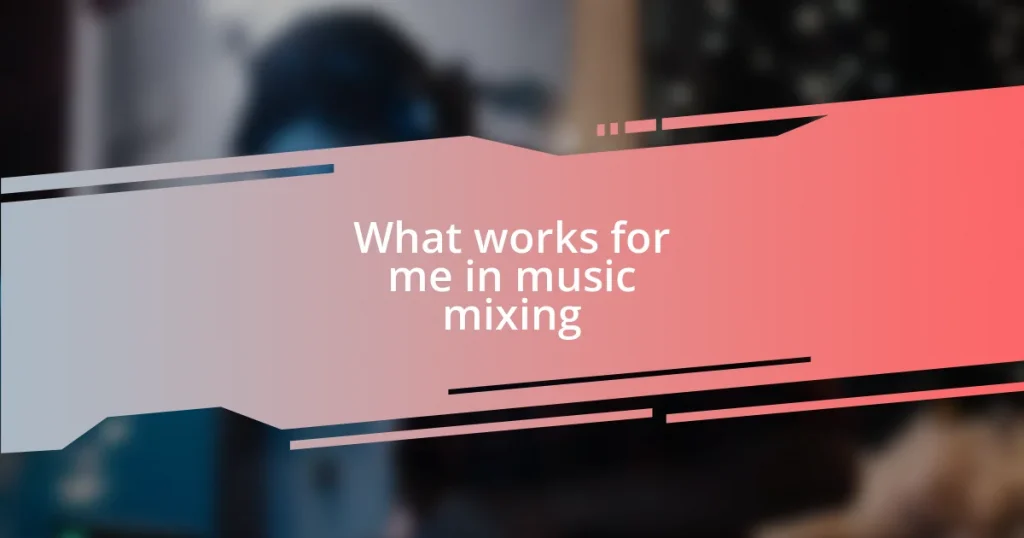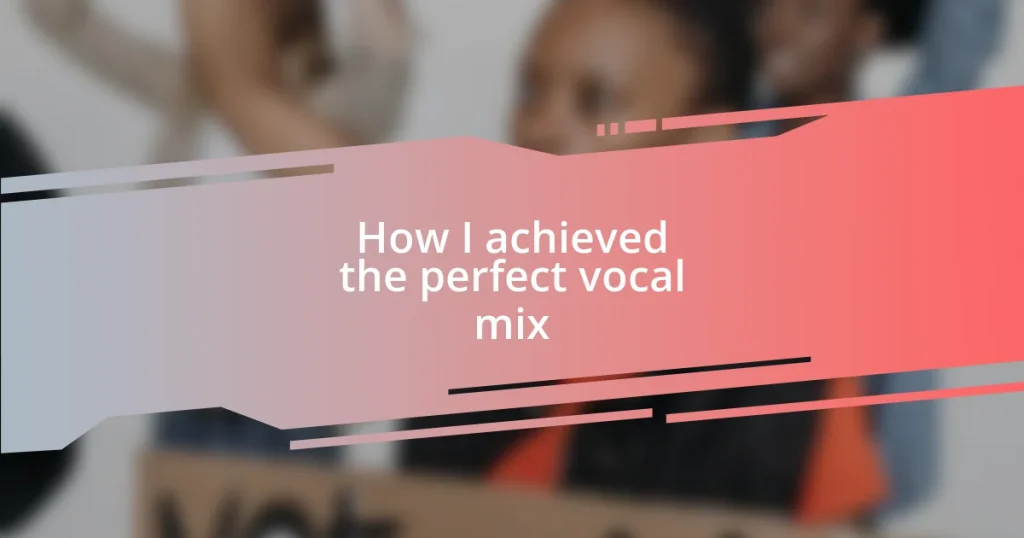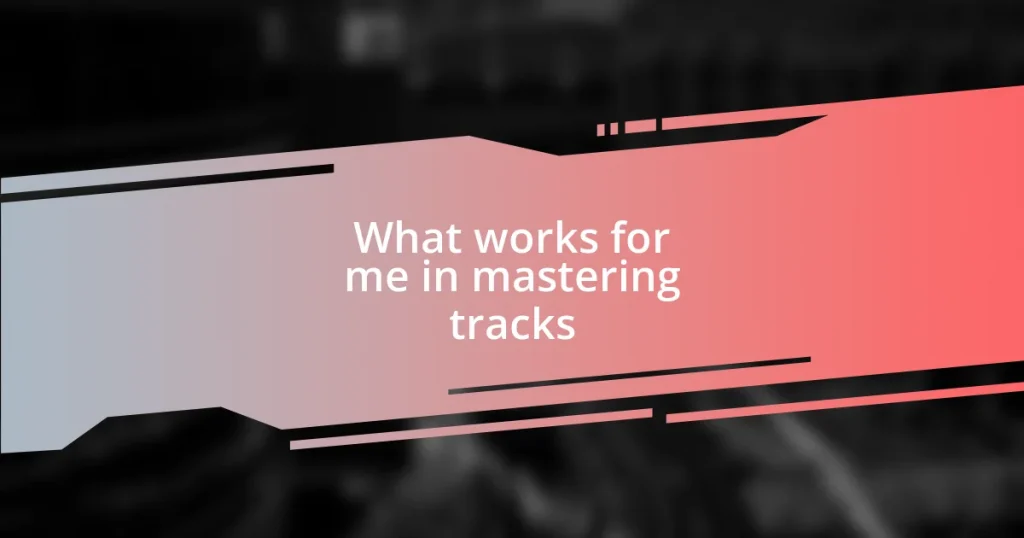Key takeaways:
- Parallel compression enhances audio by blending uncompressed and heavily compressed signals, preserving warmth while adding punch.
- Key techniques include careful signal splitting, appropriate compression settings, and the importance of blending wet and dry signals for balance and clarity.
- Common mistakes involve over-compressing, losing sight of the overall mix, and neglecting to fine-tune attack and release settings, which can detract from the emotional impact of the music.
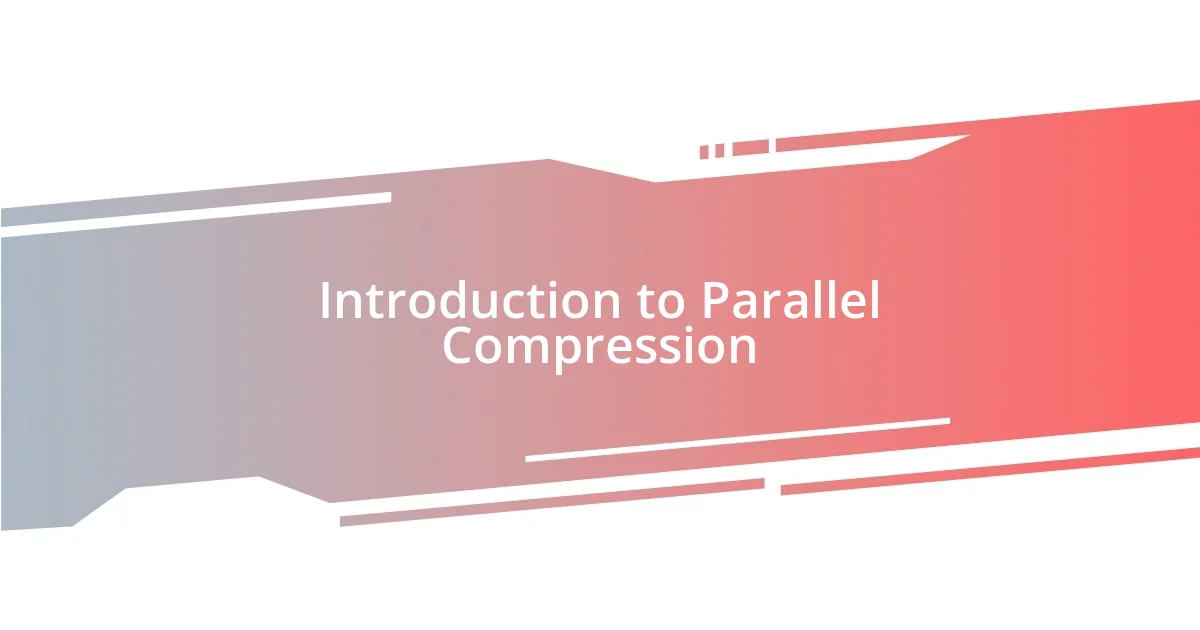
Introduction to Parallel Compression
Parallel compression, often hailed as the secret weapon of mixing, allows you to layer dynamic range with unyielding power. I remember the first time I tried it on a vocal track; the clarity and depth it added blew me away. Why settle for just pushing elements back into the mix when you can enhance them simultaneously?
This technique involves blending an uncompressed signal with a heavily compressed one. The result? Your audio retains its natural warmth while driving forward with punch. It’s fascinating how a simple adjustment in your signal flow can lead to such dramatic transformations, isn’t it? I often find that listening to the nuances in sound can make all the difference.
What I love most about parallel compression is its versatility. You can apply it to drums, vocals, or even an entire mix. I’ve found it’s particularly effective on drums, giving them that tight, aggressive sound that makes you want to nod your head. Have you ever tried it? If not, I highly recommend experimenting—it might just change your entire mixing approach.
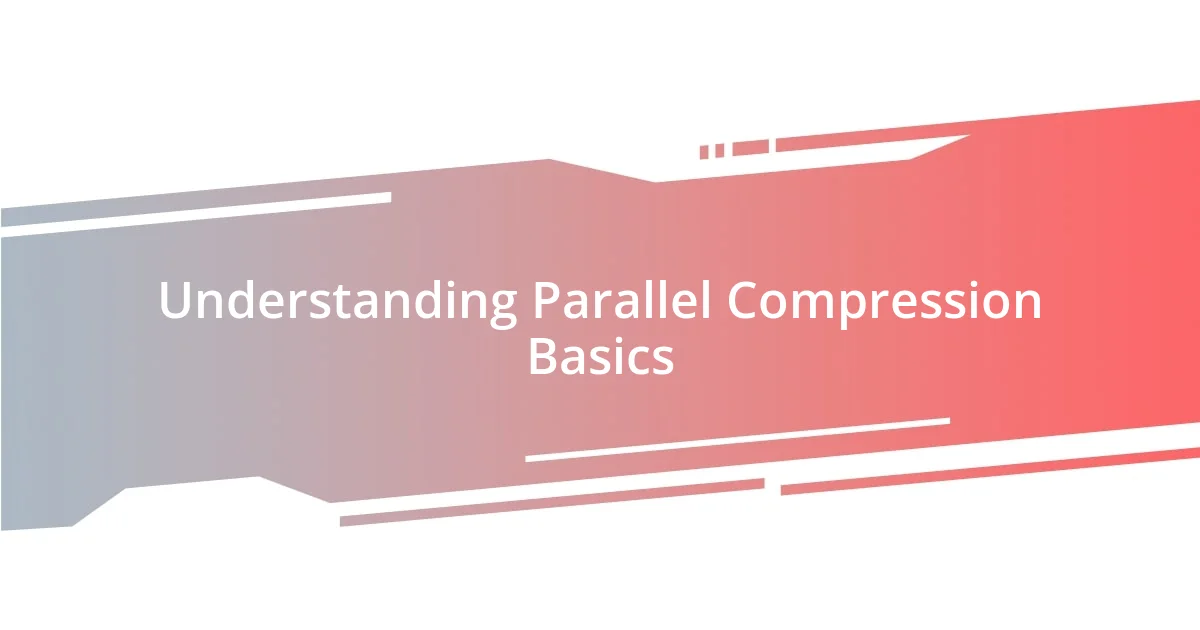
Understanding Parallel Compression Basics
Understanding the intricacies of parallel compression has fundamentally changed how I approach mixing. It’s not just about slapping on a compressor and adjusting the knobs. Instead, it’s a delicate dance of harmonizing sounds to achieve the richness and impact I want. I remember a time when I was mixing a rock track, and after applying parallel compression, the guitars suddenly felt like they were soaring above the mix, embodying the raw energy of the band.
Here are some key aspects to grasp the basics of parallel compression:
- Signal Splitting: You create two versions of your audio—a dry (uncompressed) signal and a wet (compressed) signal. This duality is essential for balancing dynamics.
- Compression Settings: I usually apply a higher ratio and lower threshold on the compressed signal for maximum impact, while keeping the attack and release settings in mind to preserve the audio’s character.
- Blending: The beauty lies in the blend; I adjust the levels of the two signals to taste, aiming for that sweet spot where they complement each other, enhancing details without losing power.
This technique requires a nuanced understanding of how each element interacts with others, bringing a whole new depth to your sound. It’s like painting with sound—layering colors until you find the perfect mix.

Setting Up Your Compression Chain
Setting up your compression chain is crucial for maximizing the benefits of parallel compression. From my own experience, the order in which you apply each component can significantly alter the sound. For instance, I prefer to route my tracks first through an EQ before hitting the compressor. This way, I can shape the frequencies before compression, ensuring that the process enhances the overall tone rather than muddying it. Have you ever experimented with your signal flow? You might find that a slight adjustment can yield surprising results.
Next, I typically place the compressor on a send track, allowing me to maintain control over the blend of dry and wet signals. This setup gives me the ability to fine-tune dynamics without losing the original character of the audio. I still remember the first time I dialed in the perfect mixture for a vocal track—those lush harmonies floated effortlessly above the instrumentation, and I couldn’t help but smile at the transformation. If you’re not using a send for parallel compression yet, I highly encourage you to give it a try; it’s a game-changer.
Lastly, always remember to adjust your levels after setting up your chain. Too often, I’ve seen projects ruin a great sound because the blended levels were off. I make it a habit to A/B test my settings regularly, adjusting the final blend until everything feels just right. It really is about finding that sweet spot—where each element shines without overshadowing the others.
| Element | Recommendation |
|---|---|
| Signal Flow | Route through EQ before compression |
| Compression Type | Use send track for wet/dry balance |
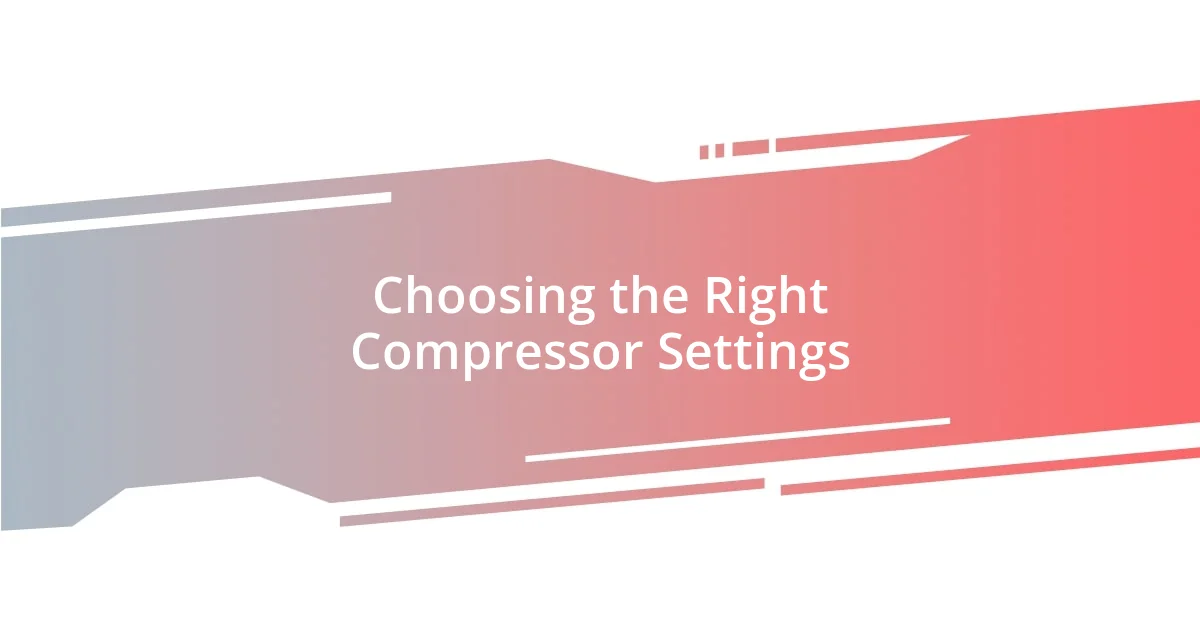
Choosing the Right Compressor Settings
Choosing the right compressor settings can feel overwhelming at first, but I’ve learned that it’s all about experimenting until something clicks. For instance, when I began using a lower threshold and higher ratio on my drums, the punchiness increased dramatically. Have you ever noticed how the kick can cut through the mix without losing its warmth? That’s the magic of fine-tuning compression settings.
I find myself constantly playing with attack and release times. It’s fascinating how a slight adjustment—like setting a slower attack on a vocal track—can let those initial transients breathe. I remember when I first tried this technique; the vocal suddenly took on a more intimate feel, wrapping around the listener like a heartfelt story. That’s the beauty of parallel compression: it’s not just about altering dynamics; it’s about enhancing the emotional connection to the music.
One key insight I often share is to trust your ears. I’ve had moments where I second-guessed my settings, only to return to a mix later and realize that the original choice was spot on. When you dial in the settings that resonate with you, it becomes an intuitive process. Have you ever felt that sense of satisfaction when everything aligns perfectly? That’s what I chase in every mix, and the right compressor settings are pivotal in achieving that balance.
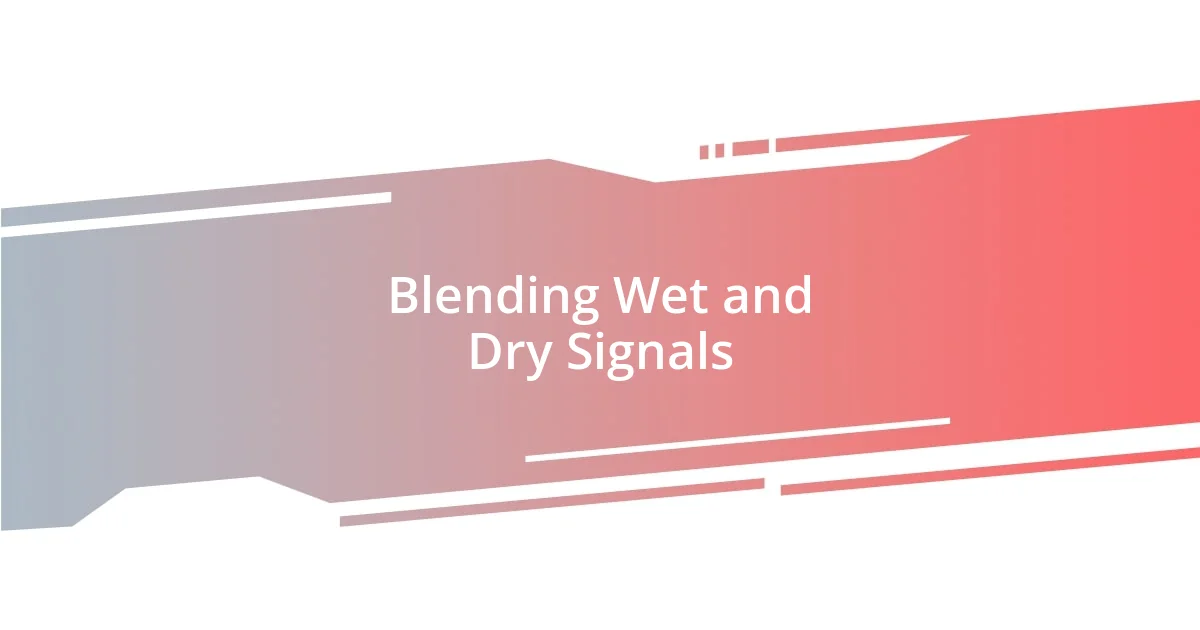
Blending Wet and Dry Signals
Blending wet and dry signals is where the magic of parallel compression really shines for me. I remember working on a guitar track where I experimented with different ratios of dry direct sound to compressed effect. The moment I found that blend, it was like the guitar stepped forward in the mix, but still retained its original warmth—like seeing a familiar face at a party that suddenly captures your attention. Have you ever had that experience where a subtle tweak completely transformed a sound?
One of the most rewarding aspects of blending is the ability to achieve depth without losing clarity. I once struggled with a vocal that sounded too processed, so I dialed back the wet signal, keeping more of the dry untouched. That simple change created a beautiful contrast where the vocals sat naturally, almost as if they were singing directly to me rather than through a screen. It taught me that sometimes less is truly more, and the right balance can evoke a profound emotional response from the listener.
When blending, I often trust my gut feeling about how different elements interact. For instance, if a snare hits too hard in the mix, I lean towards increasing the dry signal to add some realness back. I can’t tell you how satisfying it is to tweak that level and hear the mix come alive, transforming it from a flat canvas into a vibrant, dynamic painting. Have you ever adjusted your levels just in time to make the whole project click? It’s those little victories that keep me coming back to the studio, eager to explore the endless possibilities of sound.
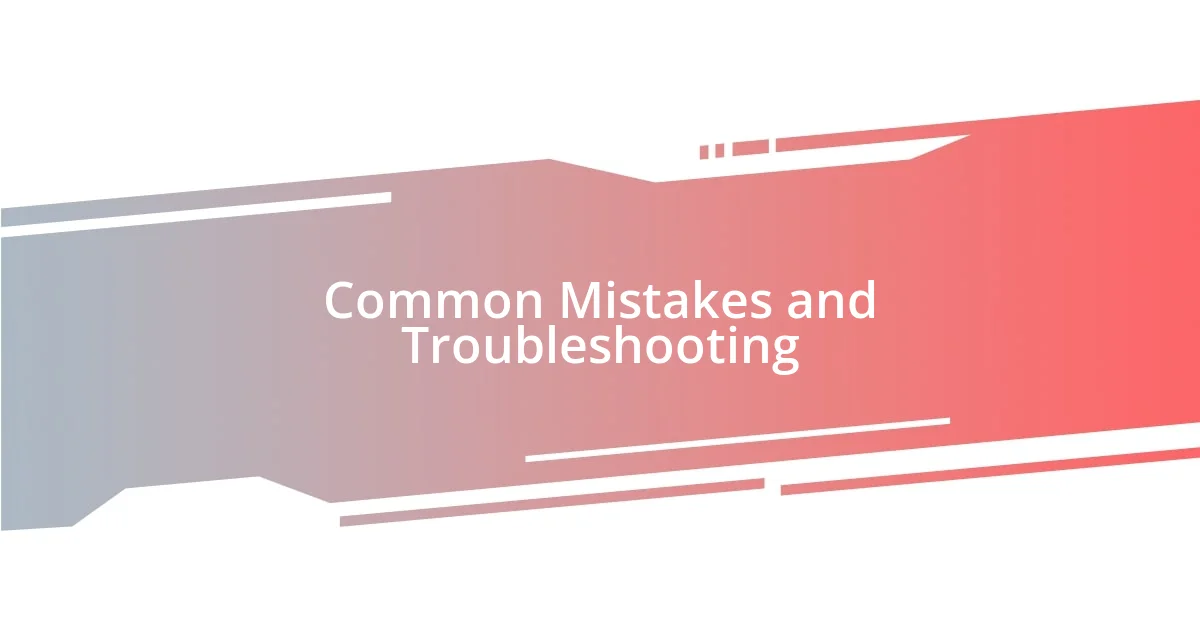
Common Mistakes and Troubleshooting
One of the common pitfalls I’ve encountered with parallel compression is over-compressing the wet signal. I recall a mix where I felt the need for more punch, so I cranked up the compression to the max. Instead of adding the desired impact, it sucked the life out of the track, making it sound flat and lifeless. Have you ever pushed your settings too far, only to realize later that subtlety can often yield a more powerful result? Finding a balance is crucial; sometimes, a light touch can create a resonance that a heavy hand can’t match.
Another mistake I’ve made—and one I see others struggle with—is neglecting to monitor the overall mix after adjustments. I remember a session where, in pursuit of the perfect kick sound, I became so focused on the individual track that I lost sight of how it fit into the entire song. The energy felt disjointed and confusing. It’s essential to step back periodically during the process and ask yourself, “How does this contribute to the whole?” Engaging with that broader perspective can lead to refreshing insights.
Finally, forgetting to fine-tune the attack and release times often leads to a less-than-ideal outcome. I once rushed through a mixing session, not taking the time to adjust these critical settings properly, and it resulted in a vocal track that felt disconnected from the instrumentation. It taught me that each element deserves its own attention. Have you experienced that moment when everything snaps into place? It’s often found in those small tweaks that many neglect. Taking the time to adjust these parameters can drastically improve how your mix communicates emotionally.

Real World Examples and Applications
When it comes to real-world applications of parallel compression, I often think of how it transformed my approach to drum tracks. I once worked with a live recording that had all the energy of a great performance, but the drums felt buried beneath other instruments. By employing parallel compression, I was able to elevate the snare and kick, giving them the punch they needed without sacrificing the overall feel. It was a bit like finding the perfect seasoning; suddenly, everything just came alive. Have you ever uncovered a sound that made everything else fall into place?
Another scenario that comes to mind is mixing strings for a cinematic piece. They had a lovely tone but sounded somewhat distant. I set up a parallel chain, compressing the string section while mixing in a touch of reverb for atmosphere. The combination provided warmth and presence, allowing the strings to soar above the mix like a bird taking flight. It’s magical how a little adjustment can evoke such powerful imagery. Do you remember a time when a sound transformed your entire emotional landscape?
Using parallel compression for bass, I found it particularly effective in creating that perfect groove. During a funky track, I had a hard time finding the sweet spot that offered both clarity and weight. By blending the compressed bass with the dry signal, I created a textured foundation that made listeners want to move. It’s moments like these that remind me of the strength found in layers. Have you experienced that rush when everything aligns just right, making you want to hit repeat? It’s in those nuances that I find true joy in the art of mixing.













